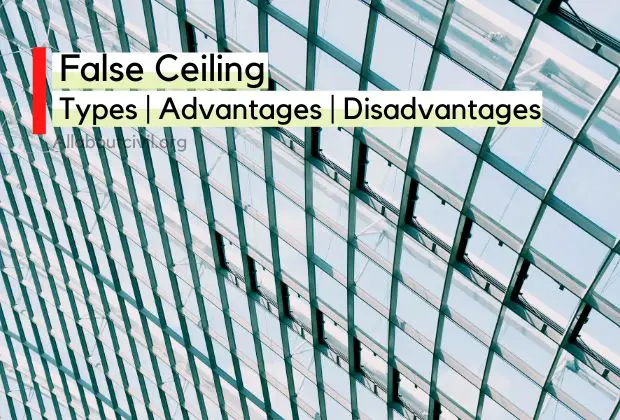What is a False Ceiling?
False ceilings are usually secondary ceilings that are suspended beneath the main ceiling using the aid of struts, suspension cords, or cords.
They are made using a variety of materials like POP (plaster of Paris) as well as gypsum boards asbestos sheets, particleboard aluminum panels, wood, etc. They can also be referred to as suspended ceilings or dropped ceilings.
Purpose of False Ceiling
The following reasons give a clear understanding of why a false ceiling is provided:
- A false ceiling gives an aesthetic appearance to your room’s interior.
- False ceiling act as sound and thermal insulation and keeps your room cool and noiseless.
- False ceilings can also be provided to adjust high ceilings.
- It can be provided to conceal lighting, cables, and AC without any outward exposure, which makes the room more organized.
- It also acts as an antimicrobial element, often provided in the health centers and storage areas.
Types of False Ceiling
Based on their materials, uses, and appearance false ceiling is divided into the following types:
- Plaster of Paris Ceiling
- Gypsum Ceiling
- Fiber Ceiling
- Wooden Ceiling
- Glass Ceiling
- Metal Ceiling
- Synthetic Leather or Cloth Ceiling
1. Plaster of Paris Ceiling(POP Ceiling)
Plaster of Paris or POP is the most common and widely adopted type of false ceiling material. It is obtained by heating gypsum to a certain degree.POP is considered to be the cheapest false ceiling material among others.
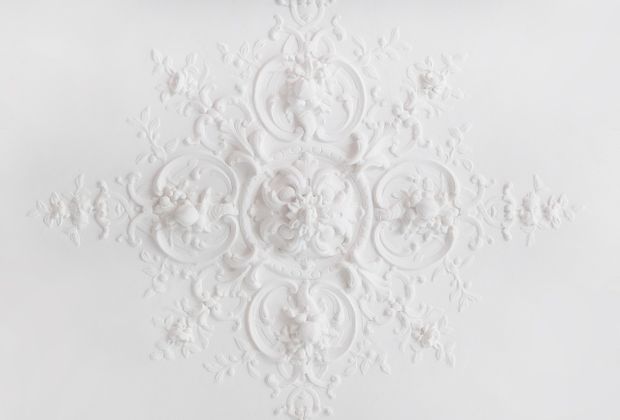
POP ceilings procedure is simple but requires skills to achieve better outcomes. At first, Glue like paste is created by mixing POP power and water, and the paste is applied to fibreboard, wooden boards, or metal framing to make a ceiling.
Advantages of Plaster of Paris (POP ceiling)
- POP enhances interior appearance.
- POP has High durability and can last for a longer duration.
- It is fire-resistant.
- Requires less maintenance.
- Lightweight and durable.
- Can be molded into required shapes.
- Act as a thermal insulator.
- The chances of cracks are very low.
- The surface can be coated with different colors to match the interior.
Disadvantages of Plaster of Paris (POP ceiling)
- POP work requires skilled labor to achieve the desired outcome.
- POP ceilings are expensive.
- The repair process is not easy.
- Not suitable for moist areas/climates.
- A lot of wastage and cleaning are involved.
Suggested Read – Types, Uses, and properties of Plaster of Paris
2. Gypsum Ceiling
Gypsum false ceiling is made by using gypsum material that is obtained from calcium sulfate. These false ceilings are lightweight, thermally insulated, sound insulated, and fire-resistant.
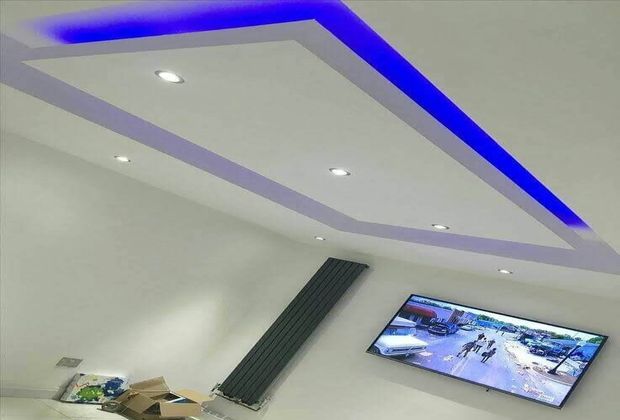
The gypsum false ceiling is made of square boards and is hung using an iron framework. These boards can be finished with paints, laminates, or wallpapers according to the required design to give them a great look.
Types Of Gypsum Boards
- Regular Gypsum Board
- Fire Resistant Gypsum Board
- Moisture Resistant Gypsum Board
- Fire and Moisture Resistant Gypsum Boards
Advantages Of Gypsum False Ceiling
- These are lightweight and easy to install.
- Gypsum boards are fire-resistant.
- Gypsum false ceilings act as thermal and sound insulation.
- These are easy to clean.
- They can provide different shapes and textures such as plain, curved, stepped, coffered, etc.
- Gypsum boards are manufactured in factories, hence they come in good quality and give smooth finishes with minimal joints.
Disadvantages of Gypsum Ceiling
- It is not easy to remove or repair a gypsum ceiling. So the whole ceiling must be removed.
- It cannot be used in damp areas such as the bathroom, toilet, laundry area, etc.
- It cannot be molded as POP false ceilings.
- Chances of fungal growth are high if there is any leaking in Ac pipe or roof ceiling leak which may create moisture conditions.
3. Fibre False Ceiling
Fiber false ceiling is widely adopted in commercial buildings due to their low cost and high-efficiency properties. The material for fiber false ceiling is made from a mixture of synthetic and natural materials such as tars, vegetable fiber, bitumen, and wood fibers.
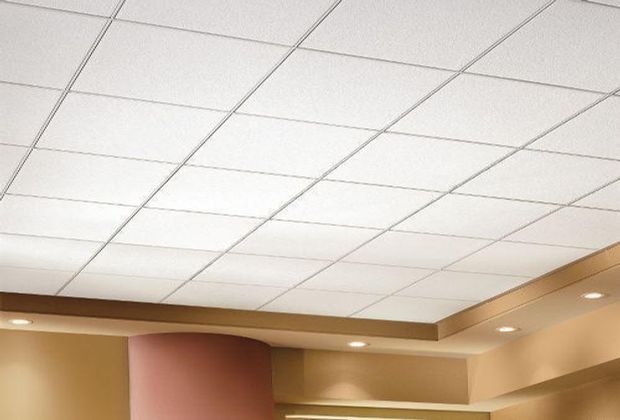
Fiber false ceiling is well-known for its excellent insulation properties, including soundproofing as well as acoustic nature.
These types of false ceilings can be seen in commercial buildings such as retail shops, shopping malls, and offices.
Advantages Fiber false ceiling
- The installation process is easy and simple.
- Fiber false ceiling offers great heat and sound insulation properties.
- they also act as fire-resistant.
- It offers more hardness and toughness.
Disadvantages Fiber false ceiling
- Not suitable for residential buildings due to poor appearance.
- Not suitable for moist areas.
4. Wooden False Ceiling
Wooden false ceiling is widely adopted in residential buildings as it offers a great aesthetic appearance and enhances the interior of the room with its natural textures and patterns. It can also be adjusted to your design by giving various finishes, or paint.
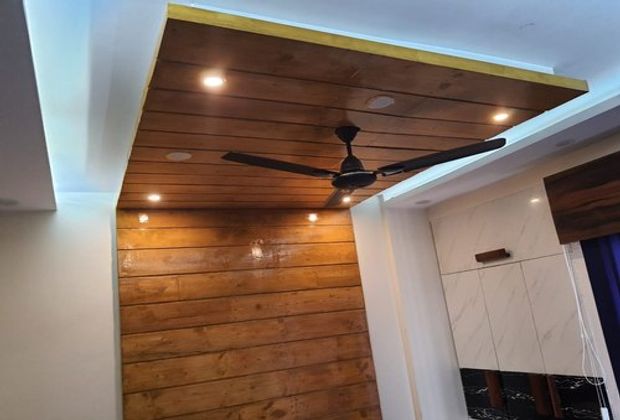
These types of false ceilings are not suitable for commercial buildings as they are expensive.
Advantages Wooden false ceiling
- Installation process is quick and easy.
- Longer lifespan.
- Appearance can be changed with various paints and finishes.
- Act as soundproof.
- Best suited for cold regions.
Disadvantages Wooden false ceiling
- Very expensive.
- These types of ceilings are susceptible to termite attack and warping.
- Prone to fire damage.
- The room has to be thermally controlled to reduce the moisture.
- Maintenance cost is very high.
- Very costly.
5. Glass False Ceiling
Glass is one of the most popular materials that are used all over the world. Making false ceilings with this material can improve the aesthetical appearance of your interior.

Glass is a non-crystalline material with brittle and transparent properties. Most commonly adopted to create decorations and lighting works in residential buildings.
These are used in the form of panels in commercial buildings such as offices, restaurants, etc.
Advantages of Glass False Ceiling
- The glass ceiling gives a great appearance to the room’s interior.
- Act as a heat insulator.
- Creates an illusion, making smaller rooms look bigger.
- Offers various options in patterns, laminates, and colors.
Disadvantages:
- Requires skilled workers, to handle and install with care.
- Regular maintenance and cleaning are required.
- Dust and dirt are clearly visible on the glass.
- Very Costly.
6. Metal False Ceiling
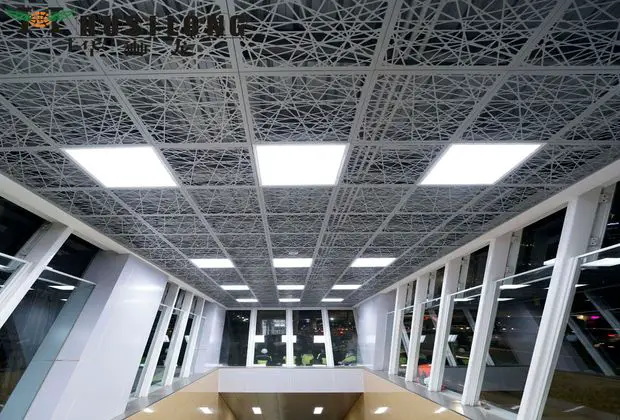
Metal false ceiling is a type of false ceiling that offers a variety of styles, textures, and finishes. Aluminum and galvanized iron are the most common metals used in false ceilings. When they are polished they offer a shining appearance which enhances the interior look.
Advantages Metal false ceiling
- Installation process is quick and easy.
- Longer lifespan.
- Do not crack or warp over time.
- They are fire-resistant.
- Metal tiles/panels are easily removable and re-attachable.
- Maintenance costs are very low.
- Low installation cost and easy to repair.
Disadvantages
- Metal panels are expensive.
- Requires coating to protect them from corrosion.
7. Synthetic Leather or Cloth Ceiling
The materials used for these kinds of ceilings can be either cloth or leather. Since both of these materials are made by humans, they are able to be made into any shape, form, or style that enhances the appearance of the interior of the structure.
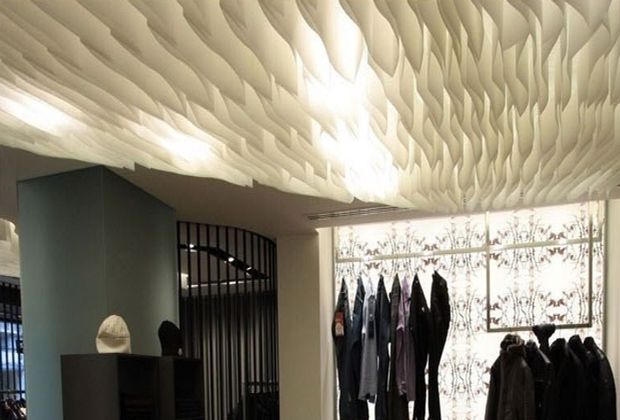
Since they are dust-catchers and are not able to transfer light property, they are only utilized in temporary tents and other temporary structures.
Advantages:
- Installation process is quick and simple.
- Offers a great aesthetic appearance.
- Low cost.
Disadvantages:
- High chances of dust and stains accumulation.
- Does not allow light, making the room darker.
- Not suitable for home decoration.

